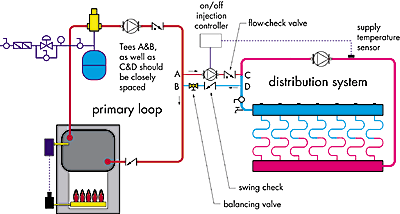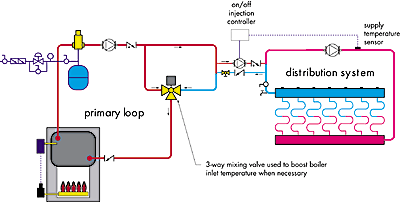Inspirations From The Past
John Siegenthaler
Those of you who've been installing hydronic radiant heating systems during the past few years have no doubt heard about, if not used, injection mixing for water temperature control. Judging by the schematics and installation photos I've seen, this method of water temperature control has grabbed a sizable share of the market in recent years.
But how many of you state-of-the-art techies used it 10 years ago? I know I didn't. I hadn't even heard of injection mixing back then. When I first saw it, the concept looked completely foreign to the familiar piping of a three-way or four-way mixing valve. I was somewhat skeptical of this "new" mixing method (largely due to my own lack of understanding).
After studying the piping concepts and checking out thermodynamic implications, injection mixing began making sense. In fact, the more I studied it, the more I came to appreciate its elegance. I soon marveled at the brilliance of the unknown designer who, undoubtedly through a flash of inspiration, came up with the idea back in the early 1990s.

Off By A Few Decades
As I later found out, the visionaries who laid the groundwork for injection mixing did so during the 1960s rather than the 1990s. I discovered this while reading a publication entitled "Primary Secondary Pumping Application Manual," bulletin No. TEH-775, from the Bell & Gossett division of ITT. Some of you probably have a copy of this buried among the dozens of product binders on your office shelves. If so, move it to the "must read" pile on your desk as soon as you finish reading this column.The unassuming black and white publication bears a 1968 copyright. It consists of double-spaced type and hand-drawn piping schematics that surely originated from an engineer - probably Gil Carlson and some of his associates. Although it has none of the flash of modern publications, nearly every page is a gold mine of ideas and insight that many of us wouldn't discover and use until decades later.
After laying out the basic tenets of primary/secondary piping, the manual goes on to show several applications for what is now considered the premier method of hydronic piping. On Page 30, the discussion turns to - of all things - injection pump mixing! My eyes popped open in near disbelief when I came across that section title. Reading on through the next several pages was like discovering the Dead Sea scrolls of hydronic heating. The concepts and piping details were almost identical to what I thought was surely the most recent discovery in water temperature control.
Here's a quote from the first sentence in that section, (remember this was written in the 1960s): "The injection pump has been widely used for reset control both in the boiler(equipment) room and at secondary zones." The piping schematic that followed showed the injection pump being controlled by both the supply water temperature and outdoor air temperature. Virtually the same concept we use in our "modern" systems.
What the manual didn't show or discuss was a microprocessor-based controller that could modify the electrical signal supplied to the pump allowing it to run at variable speeds. Herein lies the difference between how our predecessors used injection mixing and how most of us use it today.
The Wet Heads of the 1960s obviously didn't have microprocessor-based variable speed controls for injection mixing. Instead, their control scheme simply cycled the injection pump on and off. Perhaps that sounds rather crude in comparison to our current variable speed technology, but it worked then and can work today. Let's look at the concept and necessary piping details.

A Matter Of Averages
On/off injection mixing pushes "spurts" of hot water into a constantly circulating distribution system. The longer the injection pump stays on, the warmer the distribution system gets. From a control standpoint it's necessary to inject hot water until the water supplied to the distribution system rises a few degrees above the target temperature. At this point, the injection pump is turned off.The distribution system continues to circulate the water without further heat input until the supply temperature decreases a few degrees below the target temperature. At that point, the injection pump is turned back on. This control method maintains an "average" supply temperature very close to the target value.
The narrower the temperature differential of the control operating the injection pump, the closer the supply temperature remains to the target temperature. However, if the differential is too narrow the injection pump will experience rapid on/off cycles. The B&G manual even suggested a minimum pump on-time of 30 seconds to prevent the motor from burning out due to excessive operation of the start windings used in earlier induction motor pumps. Modern wet-rotor circulators all use PSC (permanent split capacitor) motors that don't have start windings, and are not subject to this constraint.
Since the water temperature supplied to the distribution system cycles up and down, it's up to the thermal mass of the distribution system to buffer these energy input pulses into a relatively smooth heat output. A concrete floor slab is perfectly suited to the task. The slab's thermal mass easily converts the fluctuating water temperatures into a smooth heat output.
On/off injection mixing is adaptable to both setpoint control and outdoor reset control. In the latter case, the control continually recalculates the target supply water temperature based on the outdoor temperature and its reset settings. It then regulates the on- versus off-cycle time of the injection pump to steer the average water temperature toward this target value. This is referred to as "averaging" reset control. If the average water temperature drops below the target temperature, the controller lengthens the on-cycle of the pump and vice versa. It's a simple, self-stabilizing control algorithm available as an off-the-shelf product from at least one hydronic controls manufacturer.
A schematic showing the piping of an on/off injection pump to regulate the temperature supplied to a radiant floor system is shown in Figure 1A. For comparison, an untouched reprint of Figure 48, from the previously cited B&G manual, is shown in Figure 1B. Notice any similarities?
The balancing valve shown in the return injection riser should be set so that the injection pump runs continually under design load conditions. Failure to install or set this valve will result in short cycling of the pump. The design injection flow rate can be determined and set in the same manner as for variable speed injection mixing. (See the December 2000 Hydronics Workshop column "Twist, Turn & Tweak" for methods of doing so.)

Oscillation Vs. Modulation
On/off injection mixing has strengths and limitations relative to variable speed injection mixing.One strength is that there's no limitation on the motor horsepower of the injection pump. Most presently available variable speed injection controllers are limited to 1/6-horsepower motors, due to the solid state electronics used. Granted, this is not a huge limitation, considering that even a 1/25-horsepower injection pump can transfer around 500,000 Btu/hr. into a low temperature distribution system, given the right operating conditions. Still, there may be times when the required injection pump exceeds the power limitation of a variable speed control. A relay or contactor operated by the on/off injection pump controller would be used to switch a larger pump on and off.
Another advantage is that a flow-check valve can be installed in one or both of the injection risers to prevent migration of hot water into the distribution system when there's no demand for heat (but when the primary loop could still be circulating hot water to service another load). Variable speed injection systems cannot use flow-check valves because they cause surging of the injection flow at low pump speeds. When flow-checks are installed in the injection risers, the latter also can be routed in any direction from the primary loop to the distribution system. When variable-speed injection mixing is used, the risers must form a thermal trap to prevent hot water migration into the distribution system.
Where there are strengths, so too are there weaknesses. One is that on/off injection, because it is not a modulating process, cannot provide boiler inlet temperature protection as can variable speed injection mixing. A separate mixing valve could be installed in the boiler loop to provide this protection when necessary (as shown in Figure 2), but this can get expensive on larger systems.
I also would be hesitant to use on/off injection mixing with low-mass heat emitters, such as fin-tube baseboard or a hydro-air coil. My concern is that the cyclic variations in supply water temperature could, under some circumstances, result in sustained piping expansion/contraction noises. In a hydro-air system, the concern is noticeable variations in supply air temperature.
Still, I feel on/off injection mixing has its uses when paired with a high thermal mass distribution system. A small wet-rotor circulator paired with a simple Aquastat or reset control is arguably one of the least expensive water temperature control options available, especially for commercial floor heating jobs. I have seen on/off injection pumping very successfully deployed to control the floor heating system in a 70,000-sq. ft. commercial building in northern Canada.
We're Standing On Their Shoulders
It continues to amaze me how many of our present-day piping concepts are actually "redeployments" of ideas originally developed back in the 1950s and 1960s. The concept of injection mixing is but one example of how our hydronic ancestors "pushed the envelope" using the technology available to them. Time and again, they found ways of using simple hardware to manipulate the principles of thermodynamic and fluid mechanics in previously unheard of ways. We certainly can learn from studying their accomplishments, especially the underlying sciences they employed.Our industry will occasionally have opportunity to refine some of the concepts of these early hydronic pioneers. Variable-speed injection mixing is a good example. The refinements we make will be judged over time. Hopefully our "modern" hydronic systems will earn the same respect from those who follow, as our predecessor's systems did from us.
Looking for a reprint of this article?
From high-res PDFs to custom plaques, order your copy today!









